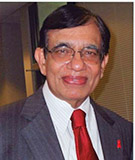
Strengthening Your SELF-Defense against Diseases – PART VIII
CUTTING YOUR CANCER RISK

Another New Year has arrived and it’s time to take stock of the year that just passed and adopt new resolutions that will keep us healthy, happy and more productive in future. As we speak, the United States is in the middle of five epidemics – cardiovascular diseases (heart attacks), strokes, cancer, diabetes and obesity. To a great extent, all of them are interrelated. Prevention of heart disease has been covered in previous issues. So, in this issue, we will concentrate on prevention of cancer, the second biggest killer in the country. But first a sobering statistic: “Half of all men and one third of women will get one of the 100 plus forms of cancer in their lifetime,” as per a recent AARP Health bulletin. Here are some tips to cut down your cancer risk.
The causes and answers for cancer
Based on the extensive research done by British epidemiologists Sir Richard Peto and Sir Richard Doll of Oxford University some 15 years ago, here are the major lifestyle factors with percentages that contribute to the cancer epidemic.
-
Diet (35%): The fried, fatty, greasy western diet with its improper ratio of fat, salt, sugar, proteins, vegetables, fruit and starch is the main culprit. An excess of sugary carbonated beverages (colas), meats especially charbroiled and barbecued, and increasing obesity (excess of calories and fats) are key factors. A plant-based diet, low in fat, salt and sugar, rich in fruits and vegetables with whole wheat goes a long way in preventing cancer.
-
Smoking (30%): Smoking kills. Apart from cancers of the lung, smoking also causes cancers of the larynx, pharynx, esophagus (gullet), kidney, pancreas and even liver. Half of all regular smokers die prematurely from a smoking-related disease.
-
Reproductive hormones, mainly estrogens (10%): Birth control pills and hormone replacement therapy (HRT) do increase the risk of cancer. With HRT, the increased risk of breast and endometrial cancer after 20 years of treatment is estimated at 20%.
-
Infection (10%): In many parts of the world, especially in developing countries, a large number of cancers are caused by parasites, bacteria and viruses. In the U.S., Hepatitis B and C, (hepatic carcinoma) HIV and AIDS viruses (Lymphoma and Kaposi’s sarcoma), HPV virus (Ca of Cervix) are the major culprits. Also, chronic bladder infections can lead to bladder cancer. Take steps to prevent or treat these infections as much as they are applicable to you.
-
Alcohol (5%): You are already aware that heavy alcohol usage leading to hepatic cirrhosis can lead to liver cancer but alcohol has also been implicated in cancers of esophagus, throat, larynx and breast too. So, stay within the safe drinking limits, if you do drink — no more than two glasses of wine for males and only one for females per day.
-
Electromagnetic Radiation (4%): Ultraviolet radiation from sunlight (always use sunscreen for skin protection), radon gas in the environment, radioactivity from nuclear power stations and nuclear waste dumping, medical X-Rays and CT scans can cause cancer. We are always surrounded by electrical fields that include radio waves, microwaves, electrical power lines, etc. Even your computer screen can emit enough radiation if you sit in front of it for too long. So beware!
-
Pollution and Food additives (2%): Environmental pollution, including industrial waste, air pollution with gasoline fumes, chemicals used in food addictives, cleaning and gardening products, by-products of agriculture and more is yet another risk.
-
Occupational hazards (2%): There are many in this category too. It is well known that asbestos workers develop mesothelioma and lung cancer, radiologists, radiographers and others who are exposed to ionizing radiation may develop leukemia, lung, breast and bone cancers, etc.
-
Physical inactivity (1.5%): Sedentary occupations are risk factors for cancer. Physical inactivity has now been linked to such cancers like colon, testicular, breast and ovarian cancers. Regular exercise will improve the risk by cutting down on body fat, stimulating immune function and favorably affecting the hormone balance amidst other things. So, get moving folks.
-
Medical procedures (0.5%): Immunosuppressive therapy as needed in organ transplantation, multiple X-rays, CT scans, MRIs and even ultrasound examinations – all have been implicated. As you already know, abdominal X-Rays in pregnant women are estimated to cause about 5% of childhood leukemia.
Environmentalists have come up with other important risk factors like chemical pesticides and fertilizers and, traffic and industrial pollution as well. Everyone can decide which of these factors might be operational in any given situation. Sustained commitment to removing or modifying all the factors that might adversely affect your health would be the best way to prevent cancer. Also, as you get older, you need periodic screenings, especially for cancers of colon, breast, lung, prostate and stomach for early detection. So, discuss with your doctor.
M.P. Ravindra Nathan, M.D., is a cardiologist and Emeritus Editor of AAPI Journal. His book “Stories from My Heart” was recently released. (www.amazon.com or www.bn.com).